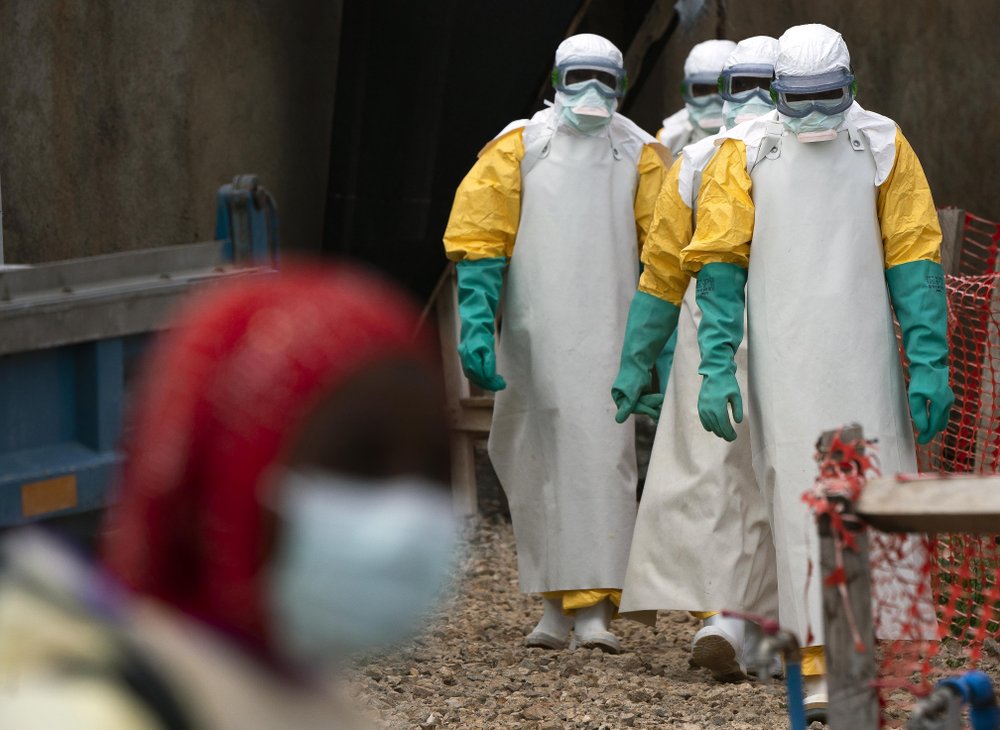Johannesburg (People’s Daily) - The second-worst Ebola outbreak in history, in the Democratic Republic of the Congo (DRC), was officially declared an international Public Health Emergency of International Concern (PHEIC) on Wednesday. This is the second time Ebola has been listed as an emergency at this level by the World Health Organization since an Ebola outbreak hit West Africa in August 2014.

In this Tuesday, July 16, 2019 photo, health workers dressed in protective gear begin their shift at an Ebola treatment center in Beni, Congo DRC. (Photo: AP)
There have been over 2,500 confirmed infections, and nearly 1,670 have died in the provinces of Ituri and North Kivu, where multiple armed groups and lack of local trust have hampered efforts to maintain the outbreak.
The virus reached Goma, home to 2 million people and a Central African transport hub since the country’s epidemic started almost one year ago. The DRC health ministry said a man who had arrived in the regional center on Sunday had been quickly transported to an Ebola treatment center.
However, the man died on the next day after he was sent off for treatment. The news triggered concerns about the virus spreading to neighboring countries as Goma is a densely populated area bordering Rwanda.
Last month, three cross-country cases were reported in Uganda, and all of them from the same family who attended the funeral in the DRC, and two of whom have since died.
Ugandan health officials indicated there was no further risk of infection.
The International Health Regulations Emergency Committee (IHREC) said it was disappointing that there had been recent delays in securing more international funds to fight the disease, which had constrained the response.
Members also reinforced the need to protect those most affected by the outbreak by keeping transport routes and borders open. Experts said it was “essential to avoid the punitive economic consequences of travel and trade restrictions, on affected communities.”
Since the outbreak, it is now classified as a level 3 emergency – the most serious – by WHO, triggering the highest level of mobilization. International agencies and officials had previously proposed to upgrade the outbreak to PHEIC when the situation deteriorated but was rejected.
WHO officials were concerned the upgrade would close the borders and cause financial difficulties for those who rely on cross-border trade.
An ongoing DRC armed conflict has hindered medical personnel rescue efforts. Since January, 200 attacks on health facilities and workers have been reported, with seven people killed.
WHO chief Tedros Adhanom Ghebreyesus said, while noting that every incident “gives Ebola an opportunity to spread..(it) gets a free ride in each and every attack.”
Despite regional challenges and its “very high” risk of spreading, front-line responders, the Ministry of Health, WHO, and other partners have been “heroic,” Tedros said, referring to the more than 161,000 people vaccinated, 140,000 contacts traced, and 71 million travelers screened, at a cost of $250 million “and counting.”
Congo will not permit the use of further experimental vaccines as it combats the outbreak because doing so risked "confusing the population," the DRC government said.
The outbreak continues to spread, due largely to mistrust from those living in eastern Congo, and armed attacks against health workers that have limited access to patients.
David Miliband, the president and CEO of International Rescue Committee, stressed that containing the virus in a conflict zone is more complex, more dangerous, and more challenging than anything the health community faced in the 2014 west Africa outbreak.
“We need to place community trust at the heart of the response“. Of the Ebola-related deaths in this crisis, 68% have occurred in the community as opposed to in health centers – a sign that people infected with the virus do not yet trust medical professionals to treat them.
Ebola spreads among humans through close contact with the blood, body fluids, secretions, infected organs, or anything contaminated by such fluids. The mortality rate is as high as 50 to 90 percent and caused over 113,000 deaths in West Africa between 2014 and 2016.


